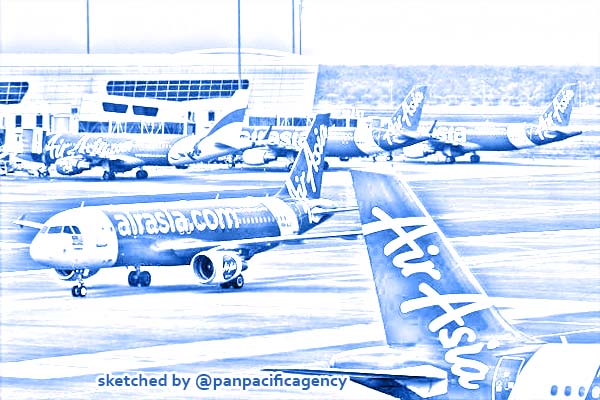Analysts maintain negative outlook for Malaysian aviation sector

AirAsia is studying a dual listing in Hong Kong, part of plans to become a pan-Asian low-cost airline player as it also moves towards setting up a joint venture in China, people familiar with the matter said on Sunday. PHOTO: EPA. Sketched by the Pan Pacific Agency.
KUALA LUMPUR, Sep 6, 2019, BT. As policy uncertainty adds to concerns regarding overcapacity, a challenging yield environment and volatile foreign exchange and crude oil market, analysts from Maybank Kim Eng have maintained a negative outlook for Malaysia’s aviation sector, reported The Business Times.
The Malaysian government recently announced that passenger service charge (PSC) rates for international flights from all airports except for Kuala Lumpur International Airport (KLIA) will revert back to 2018 levels starting October 1. At these airports, passengers on flights to countries beyond those in ASEAN will now have to pay 50 ringgit, down from 73 ringgit previously.
This was done with the aim is to spur traffic growth and offset the impact of the Departure Levy that came into effect on September 1. Passengers and airlines collectively will be able to save 200 million ringgit per annum. Meanwhile, analysts said that the news is neutral from a financial standpoint for Malaysia Airports Holdings Berhad (MAHB), though in reality MAHB is likely to be disappointed as airports tend to suffer over the longer term when there is policy uncertainty.
While taking into account all this, the action means that there would be a reduction of 200 million ringgit per annum in PSC revenue.
As such, the government would receive just 200 million ringgit per annum in revenue from departure related levies, which analysts said would be insufficient for the government to improve the industry in a meaningful way.
SEE ALSO: Malaysia: Shares close higher on Wednesday
Analysts said that this raises concerns on policy uncertainty. This is as the Malaysian government has long mooted to make the industry self-financing, but now seems to be in favour of a consumer-based measure by keeping charges low.
While the lower PSC is supportive for passenger traffic growth, analysts said that it also undermines industry reform measures. This is because for the past two years, the Malaysian Aviation Commission (MAVCOM) has engaged with the industry stakeholders to implement the Regulated Asset Base (RAB) framework beginning 2020, which will help determine airport charges.
The framework renders a weighted average cost of capital (WACC) of 8.3 per cent, which analysts believe is fair. Additionally, they understand that it is two months away from being gazetted at the upcoming October Parliament sitting.
However, with the government’s directive to reduce the PSC, it has in effect raised concerns on MAVCOM’s efforts, creating an environment of regulatory uncertainty which is not ideal for investors.
Analysts also added that with the lower PSC, the overall tax collection from the industry will be insufficient and the government will need to draw on its own funds to sustain the industry. Hence, they said that the ability to invest in infrastructure development becomes more questionable due to insufficient revenue.
Analysts also emphasised that low prices alone does not ensure success, as while Malaysia has always been one of the cheapest places in Asia Pacific for an airline to operate, it has trailed the growth rates of Thailand and Singapore.
Furthermore, analysts mentioned that only KLIA and Kota Kinabalu International Airport (KKIA) have managed to break into the international scene meaningfully, whereas other airports have remained a predominantly “local” only airport.
Therefore, analysts said that by continuing this policy, they have doubts on the long-term passenger growth rates. They added that their belief is that international traffic growth will continue to be polarised at KLIA and KKIA, and unlikely to be expanded to the airports.